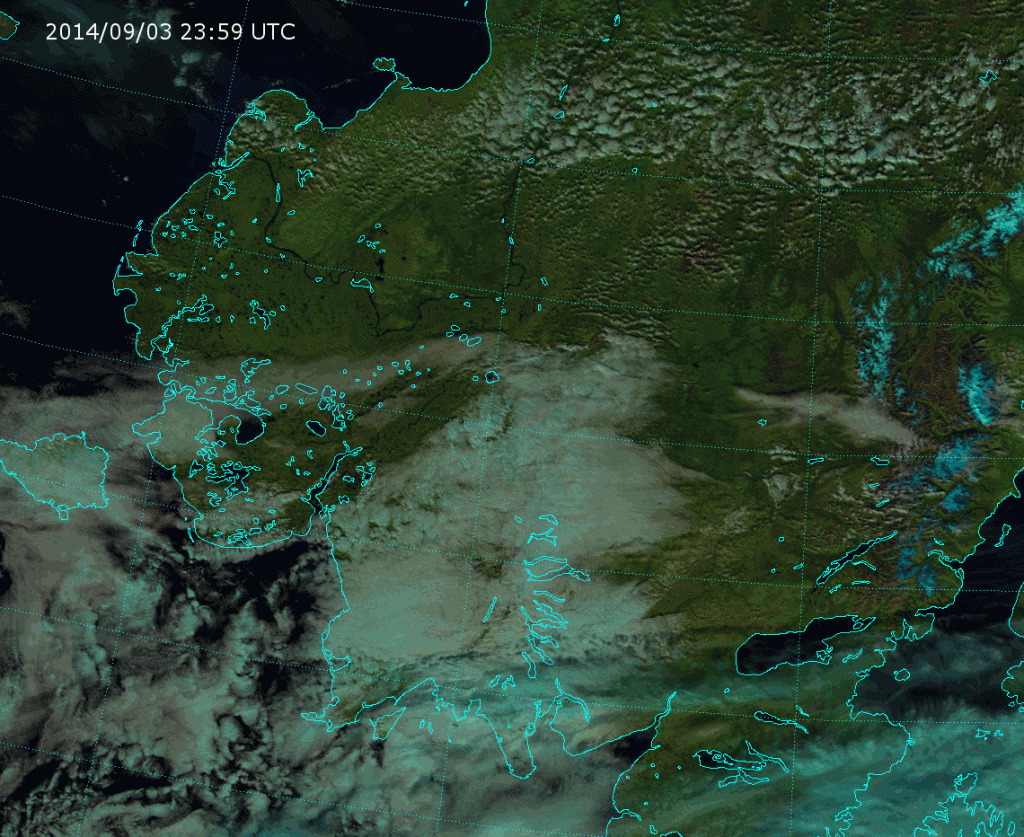The transition between winter and summer happens twice a year. Unless you live in the tropics. Then you don’t really have winter. If there are seasons there, they are “dry” and “wet”. But, at high latitudes, the transition from summer to winter is often abrupt and cannot be mistaken for anything else. It’s hard not to notice when 22 hours of sunlight turns into 2 hours of sunlight and back again the following year. For places like the interior of Alaska, it’s also hard not to notice the temperatures in the 70s F giving way to temperatures below 0 °F. (Of course, here in Colorado, our temperatures went from 70 °F to 10 °F in a period of about 36 hours hours this week. Not to brag or anything.)
Summers are short at high latitudes but, autumns are shorter. So, what can VIIRS tell us about the changing seasons?
We’re going to focus on the “Natural Color” RGB composite. In this composite, the red component is the reflectance at 1.6 µm, the green component is the reflectance at 0.87 µm and the blue component is the reflectance at 0.64 µm (a red visible wavelength). The Natural Color RGB is useful for detecting snow and ice, determining cloud top phase, monitoring vegetation and detecting flooding. So, it’s good to get familiar with it. Plus, it’s one of the best RGB composites you can make with the high-resolution (375 m) channels on VIIRS.
Here is a Natural Color RGB image of Alaska from 6 September 2014 – at the end of summer:

It’s easy to pick out the ice clouds from the liquid clouds, just as it’s easy to see the snow on the Brooks Range. They appear cyan instead of white (as they would in the True Color RGB composite). If you want to know why snow and ice appear cyan in this composite, click here. But, I want to draw your attention to the third and nineteenth longest rivers in the US. Lower-48ers that didn’t click on the link are probably wondering which rivers I’m referring to. But, of course, Alaskans know which rivers I’m talking about, right?
OK, fine. Just to make sure we’re all on the same page, I’m talking about the Yukon and the Kuskokwim. These rivers are wide enough to be seen by VIIRS. Did you find them in the above image? Click on the image to see it in full resolution and make sure you see them.
Notice how the rivers are almost black. That’s because water is poorly reflective at these three wavelengths. This will come in handy later on. Now, let’s look again at these rivers a month later (7 October 2014):

Why are the rivers surrounded by brown when a month earlier the river valleys were green? Deciduous trees like to hang out in the river valleys of southwestern Alaska, and these trees have already changed color and lost all their leaves over the course of this month, leaving behind only the bare branches and trunks. This is one sign of the changing seasons. (Note, however, that it is just a coincidence that these areas appear brown here. This is a false-color composite. The brown color is due to the reduced reflectivity of the deciduous forests at 0.87 µm caused by the lack of leaves, not because the tree trunks are brown. Read this if you want to learn more.)
Another sign of the changing seasons is the additional snow present. Everywhere north of the Brooks Range is snow covered. Plus, you can see pockets of snow in the Kilbuck and Kuskokwim Mountains, the Aleutian Range and in the hills and mountains surrounding Norton Sound.
Fast forward another month to 4 November 2014:

Now, almost the whole state is covered by snow. But, look at the rivers! They are no longer black – they are cyan, which means they have frozen over. Although, if you look closely, you can see a few pixels suggesting open water on the lower sections of the Yukon, generally between Russian Mission and Mountain Village. Also, look closely where the Kuskokwim River flows into Kuskokwim Bay, downstream from Bethel – there is ice along the shores, but open water in the middle. Ice is also forming in Norton Sound and has covered Baird Inlet.
Two weeks earlier (21 October 2014), there is more of a mix of ice and open water on the Yukon and Kuskokwim:

Identifying ice and open water on the rivers is very important. When the two coexist, ice jams can occur. When an ice jam forms, it blocks the flow of the river, which can flood areas upstream of the jam. When the jam breaks, it can cause a flash flood downstream.
Ice jams, even on small rivers, can show their power:
Imagine what they can do on the third and nineteenth largest rivers in the country!
Sometimes, you don’t have much time to get out of the way. Note: you might not want to watch this one if you are prone to motion sickness:
Who remembers what happened to Crooked Creek on the banks of the Kuskokwim in 2011? Or on the Yukon River at Eagle in 2013?
Of course, once the rivers are completely frozen over, there is no threat of an ice jam or flooding. But, now that you know how to spot ice forming on these rivers in the fall, you’ll hopefully be able to spot the return of open water in the spring, when the threat returns.
To really capture the changing of the seasons, here’s an animation of the relatively cloud-free images from 3 September 2014 to 6 November 2014:

Click on the image to view the animation. It’s 17 MB, so it may take a while to load. See if you can pick out when the first ice forms on either river.